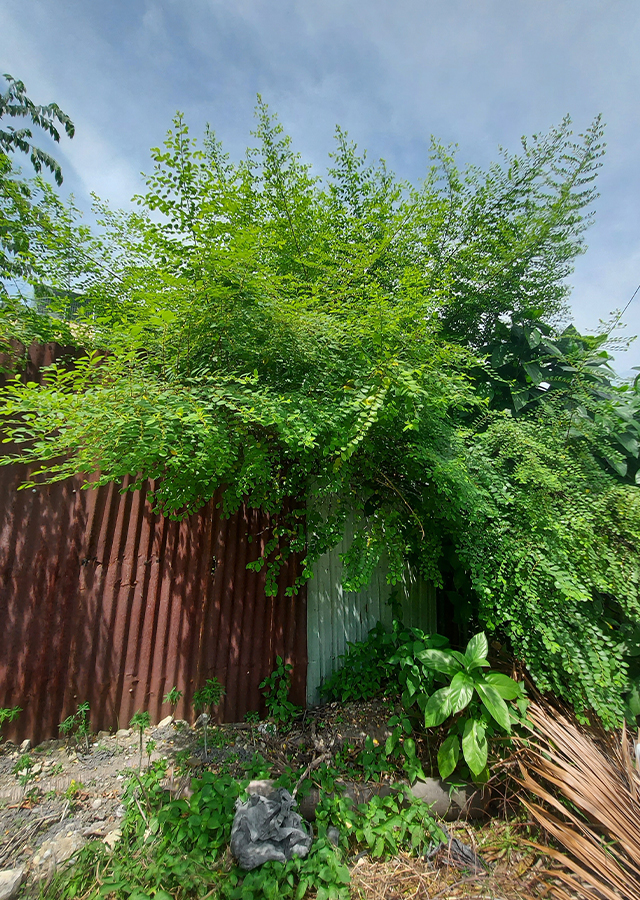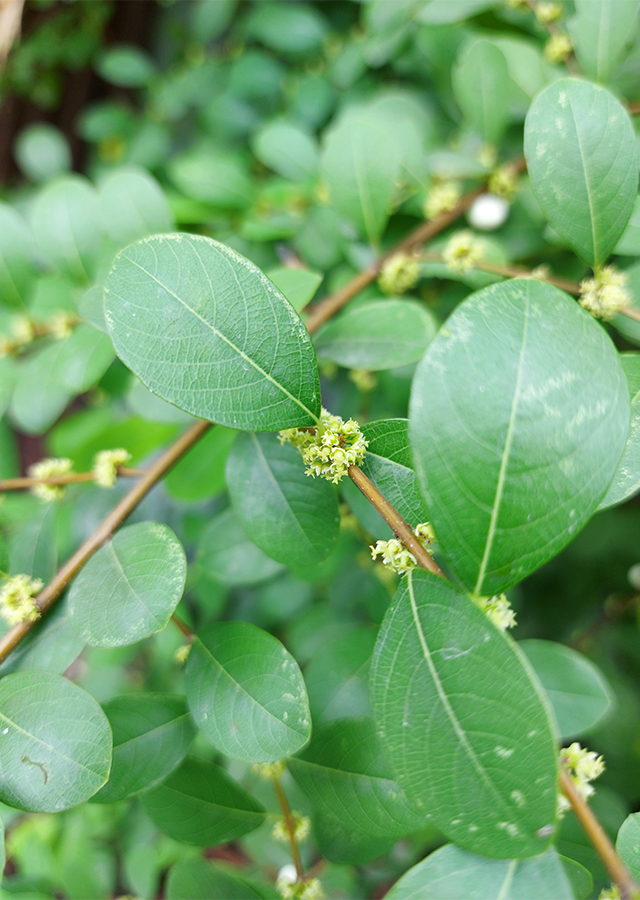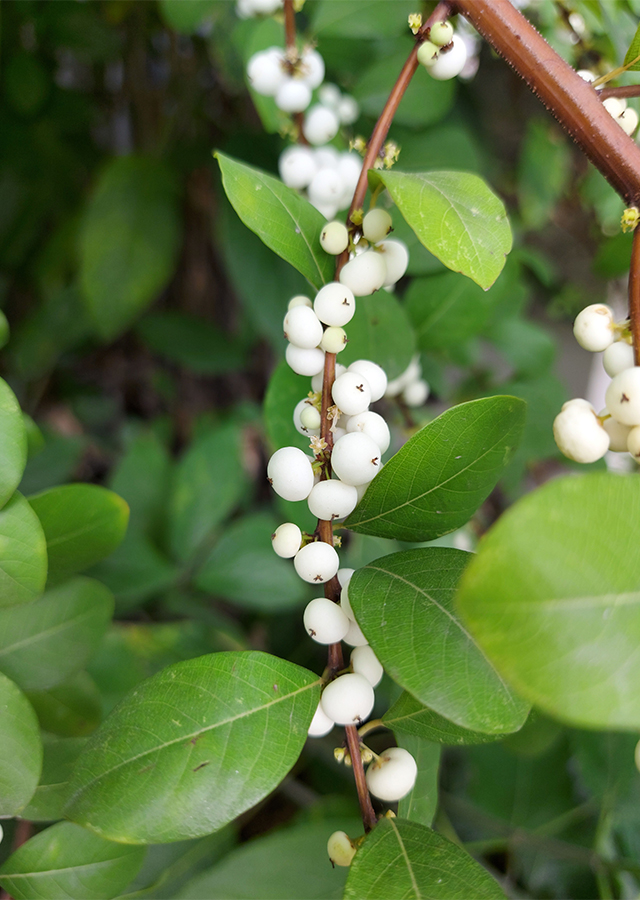Common bushweed
Flueggea virosa (Roxb. ex Willd. ) Royle
Phyllanthaceae
Location in our garden
Principal



Synonym
Acidoton virosus (Roxb. ex Willd.) Kuntze
Phyllanthus virosus Roxb. ex Willd.
Securinega virosa (Roxb. ex Willd.) Baill.
Habitus
Shrubs. A deciduous shrub or small tree with many erect or arching branches; it usually grows up to 4-7 m tall
Part Used
Leaves
Bark
Fruit
Roots
Growing Requirements
Full Sunshine
Drought Resistant
Habitat
Forest
Roadside
Rocky Areas
Shrublands
Grassland
Overview
Common bushweed is widespread in tropical Africa and Asia, from Pakistan to China and Japan, and is particularly common in South-East Asia, in Malesia, in Peninsular Malaysia, the Philippines, and Java, but very scarce in Borneo and eastern Indonesia. The species is planted in hedges and as an ornamental. It is also used medicinally. The wood is used for stakes and sticks, as well as for charcoal.
Vernacular Names
Sigar jalak, trembilutan (Indonesia), Bai fan shu, Jin gan teng (Chinese), Mukwamba, Mteja (Kenya), Omukarara (Uganda), Vellapoolam (Malayalam), Kaang khaao (Thailand), Bong nô' (Vietnamese)
Agroecology
Common bushweed is widely found along forest boundaries and associated bushland, generally in higher rainfall areas, bushland and thicket, spreading into dry areas surrounding water courses, sometimes on termite mounds, rocky slopes, and common in disturbed places, with an altitude range of sea level to 2,300 m.
Morphology
- Stems - branching monopodial plagiotropic.
- Leaves - extremely variable in shape, ellipticovate, obovate or orbicular, 2.5 to 10 cm in length, rather glaucous beneath, and rounded, obtuse or pointed at the tip.
- Flowers - actinomorphic, small; pedicels slender; sepals (4 or)5(–7), imbricate, subpetaloid, unequal, margins entire to denticulate; petals absent; disc or disc lobes present
- Fruits - capsular, dehiscing loculicidally into 3 merocarps or subbaccate, indehiscent, columella usually persistent; endocarp crustaceous.
- Seeds - 2 per locule, hilum sometimes invaginated, testa smooth or occasionally reticulate or verruculose, crustaceous; endosperm copious
Cultivation
Common bushweed propagated by seeds.
Chemical Constituents
Securine is the main alkaloid, viroallosecurinine, virosecurinine and virosine, have been recorded from the leaves, Bergenin, phyllanthidine, kaempferol, quercetin, gallic acid, daucosterol, sitosterol, flavonoid, saponnin, tannin, terpenoid, polterpen, alkaloid, cardenolide.
Traditional Medicinal Uses
- Methanol and water extracts of the leaves have shown strong antimalarial activity.
- The root is the most commonly used and most pharmacologically active part of the plant. It is seen as analgesic, astringent, ophthalmic, purgative, sedative and soporific.
- The leaves are considered aphrodisiac and laxative.
- Juice and paste of leaves mixed with tobacco is used to destroy worms in sores.
- In tropical Africa, it is used as remedy for diarrhea, the treatment of epilepsy. Root decoction given as a drink to calm children and to help them sleep.
- In south-central Zimbabwe, all plant parts are used to treat frigidity, liver, bile, kidney, testicular inflammation, sterility, urinary and venereal diseases. Root extract is drunk for treatment of pneumonia; and as contraceptive before sexual intercourse. Dried root powder applied to snake bites and wounds.
- In Western Uganda, roots and leaves are used for sexual impotence and erectile dysfunction.
- Twigs and leaves contain fleuggines A and B, two dimeric indolizidine alkaloids. Flueggine B exhibited growth inhibitory activity against MCF-7 and MDA-MB-231 human breast cancer cells.
Part Used
Reference Sources
- Fern, Ken. 2014. Useful Tropical Plants: Flueggea virosa. http://tropical.theferns.info/viewtropical.php?id=Flueggea+virosa (Accessed 02-03-2021).
- Barker, C. & P.C. van Welzen. 2010. Flueggea (Euphorbiaceae s.l. or Phyllanthaceae) in Malesia. Syst. Bot. 35: 541–551. http://www.nationaalherbarium.nl/Euphorbs/specF/Flueggea.htm.
- India Biodiversity Portal. (No date). Flueggea virosa (Roxb. ex Willd.) Royle. https://indiabiodiversity.org/species/show/259733 (Accessed 02-03-2021).
- Pl@ntUse. 2016. Securinega virosa (PROSEA). https://uses.plantnet-project.org/en/Securinega_virosa_(PROSEA) (Accessed 02-03-2021).
- StuartXchange. 2016. Philippine Medicinal Plants: Botolan. http://www.stuartxchange.org/Botolan.html (Accessed 02-03-2021).




